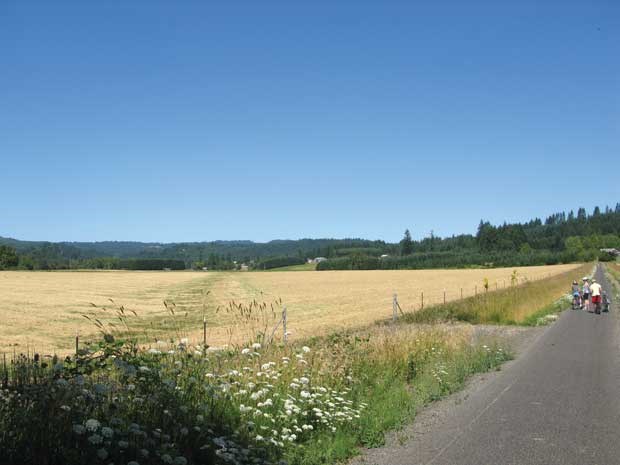VERNONIA, OREGON, WAS FRIENDLY FROM THE START.
Outside the Bridge Street Mini Mart, a woman took an immediate fancy to my son's shoes.
"Man, I love those shoes," she said at least three times. Ryan, who is 14, was looking down at his feet the way most 14-year-olds do when complete strangers talk to them.
"Thanks," he mumbled. "They're Nikes," he added, in case she hadn't noticed the swoosh down the side.
I was still admiring Ryan's shoes moments later when another woman asked me if we needed help.
"Are you lost - do you need directions?" she asked.
"No, I don't think so, thank you," I replied.
We'd just cycled from the town of Banks, 40 kilometres west of Portland and a part of rural Oregon that most visitors miss in their rush to Cannon Beach and the coast. I was beginning to wonder whether we had actually arrived in The Twilight Zone. On the opposite side of Bridge Street, I stopped to photograph Shay Park, the final resting place of 99-year-old Shay locomotive #102. I realized a car had stopped for me to do so.
The driver waved, I waved, and traffic continued. Cooling our heels down at the Nehalem River, teenage boys floated downstream in inner tubes. Ryan chugged his chocolate milk while I swigged a bottle of Sam Adams.
If it wasn't The Twilight Zone, it was a part of America I hadn't realized still existed.
Three hours earlier we'd set out from Banks on a trail that was almost too perfect: Paved, eight-feet wide and paralleled by a four-foot horse path. With few hills to slow us, we cycled through forests, past abandoned barns and across wheat fields all the more vivid for the intense blue sky above.
Trains like the Shay locomotive #102 used to ply this route laden with lumber. From the 1920s to the 1950s, the railroad transported logs from the Oregon-American Lumber Company mill in Vernonia, along with passengers and freight from nearby Keasey to Portland. The railroad stopped using the line when the mill shut in 1957. In 1960, the Vernonia South Park and Sunset Steam Railroad leased the line and ran steam train excursions until 1965.
After the line was abandoned in 1973, the state began purchasing the right of way until trail building began in 1991. The 34-kilometre Banks-Vernonia State Trail became the first rails-to-trails state park built in Oregon. It's part of a 31,000-kilometre rail-trail network built on abandoned railbeds across the U.S. The Washington, D.C.based Rails To Trails Conservancy plans to expand that network by another 14,500 kilometres.
Mid-week in mid-summer, the Banks-Vernonia Trail attracted few visitors the day we cycled: a couple of moms pushing strollers, kids wobbling on bikes with training wheels, a family pushing a boy in a wheelchair, and a runaway Black Angus steer.
Around Mile 10 of the trail, within earshot of Highway 47, we'd seen the sign: "LOST - 2 BLACK ANGUS STEERS, black with white heads, near Hwy. 47 and Nowakowski Road."
Around Mile 11, from a bridge we spotted one of them dodging traffic on Nowakowski Road. He may still be there.
Not that the trail lacks other diversions: 13 bridges and two 200metre-long, 25-metre-high railroad trestles provide a window on rural Oregon's industrial past. And for a longer visit, there are miles of side trails said to be full or railroad relics, including an old section cabin.
We crossed Dairy Creek, Beaver Creek and the Nehalem River. We stopped for a picnic near Tophill, the trail's halfway point, and occasionally we stopped to look at the Coast Mountains' foothills in the distance. Near the all-but-abandoned community of Treharne, (It's said to have a grocery store and a phone booth, but we didn't see either) weeds had consumed what might once have been a decent baseball field. The backstops loomed out of the undergrowth and we tried to walk the bases before the bugs and the pollen beat us back.
And as Ryan had pointed out: "There are probably snakes in here, too."
After our ride through the past, Vernonia brought us gently back to the present. Down at the Nehalem River the kids eventually floated out of sight. If we could have found a couple more inner tubes, we would have joined them.
IF YOU GO:
We stayed in nearby Forest Grove at McMenamins Grand Lodge, a popular and affordable spot for cyclists. Built in 1922 by the local Masonic lodge as a home for the elderly, Grand Lodge was renovated and opened as a European-style guesthouse in 2000. It features a couple of pubs on-site, a small movie theatre, restaurant and disc golf on the spacious lawns. Rooms start at US$40 a night.
For details, visit www.mcmenamins.com/GrandLodge.
For more information about the Banks-Vernonia Trail, visit www. oregonstateparks.org/images/pdf/bv.pdf.



